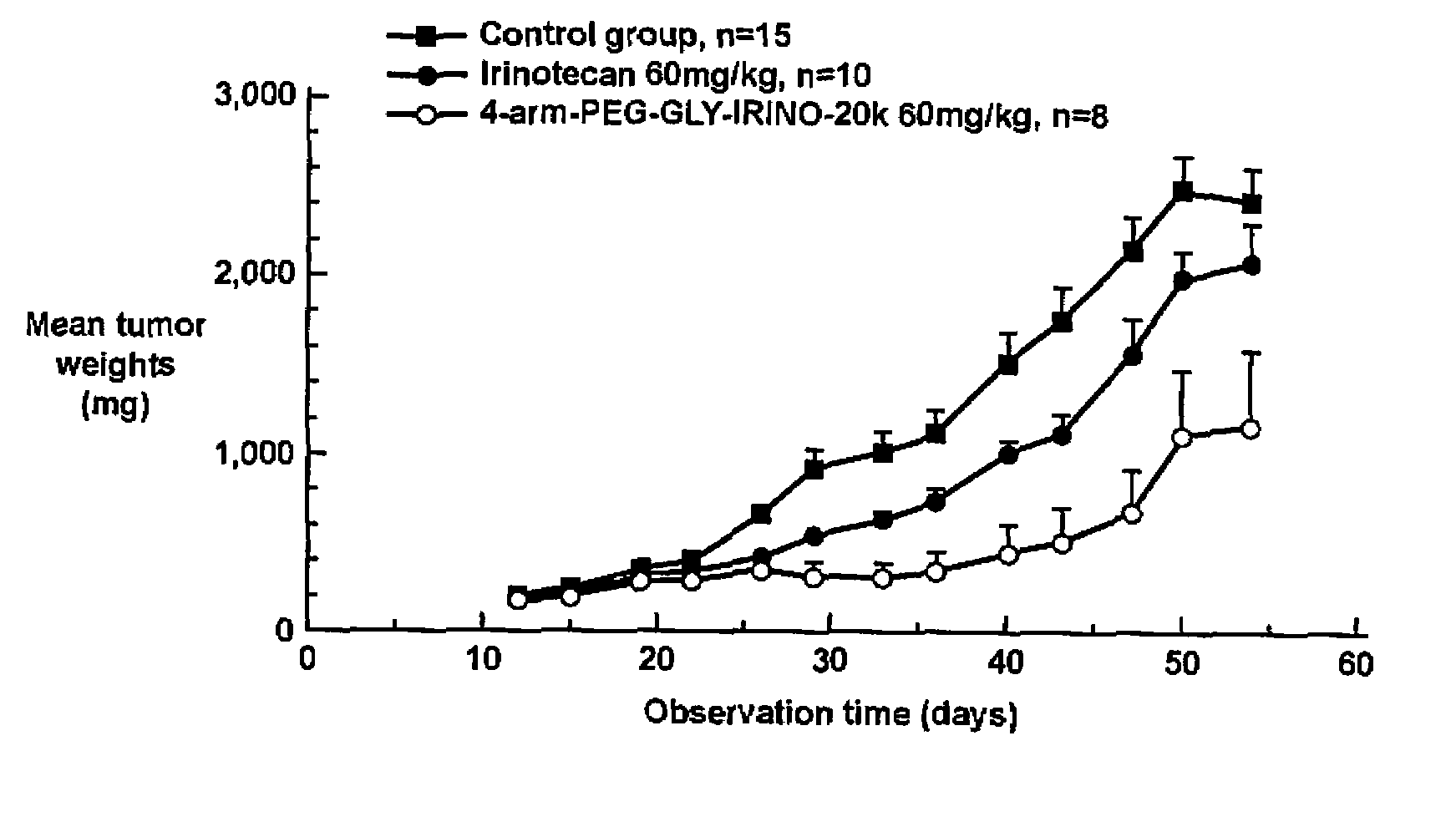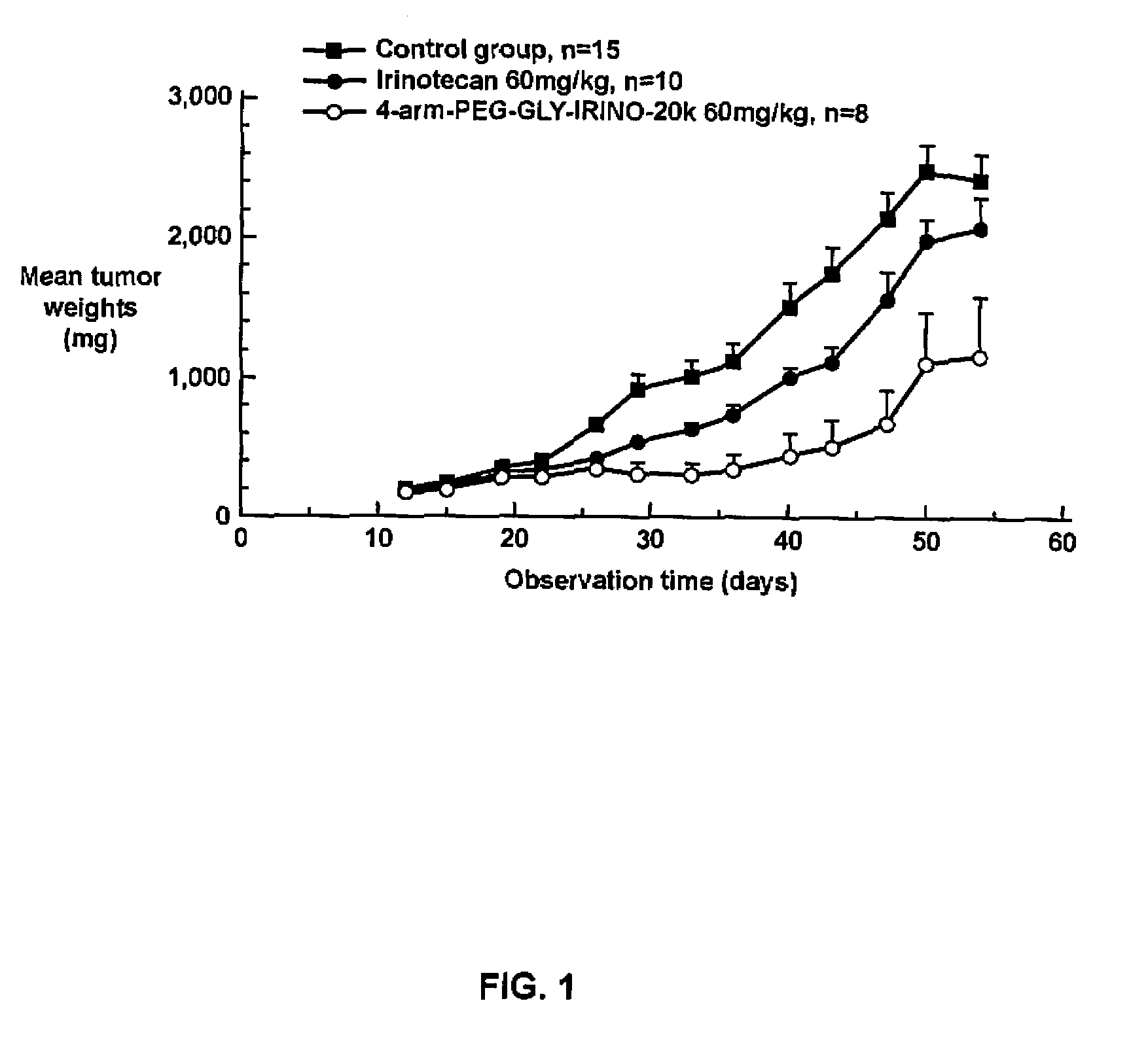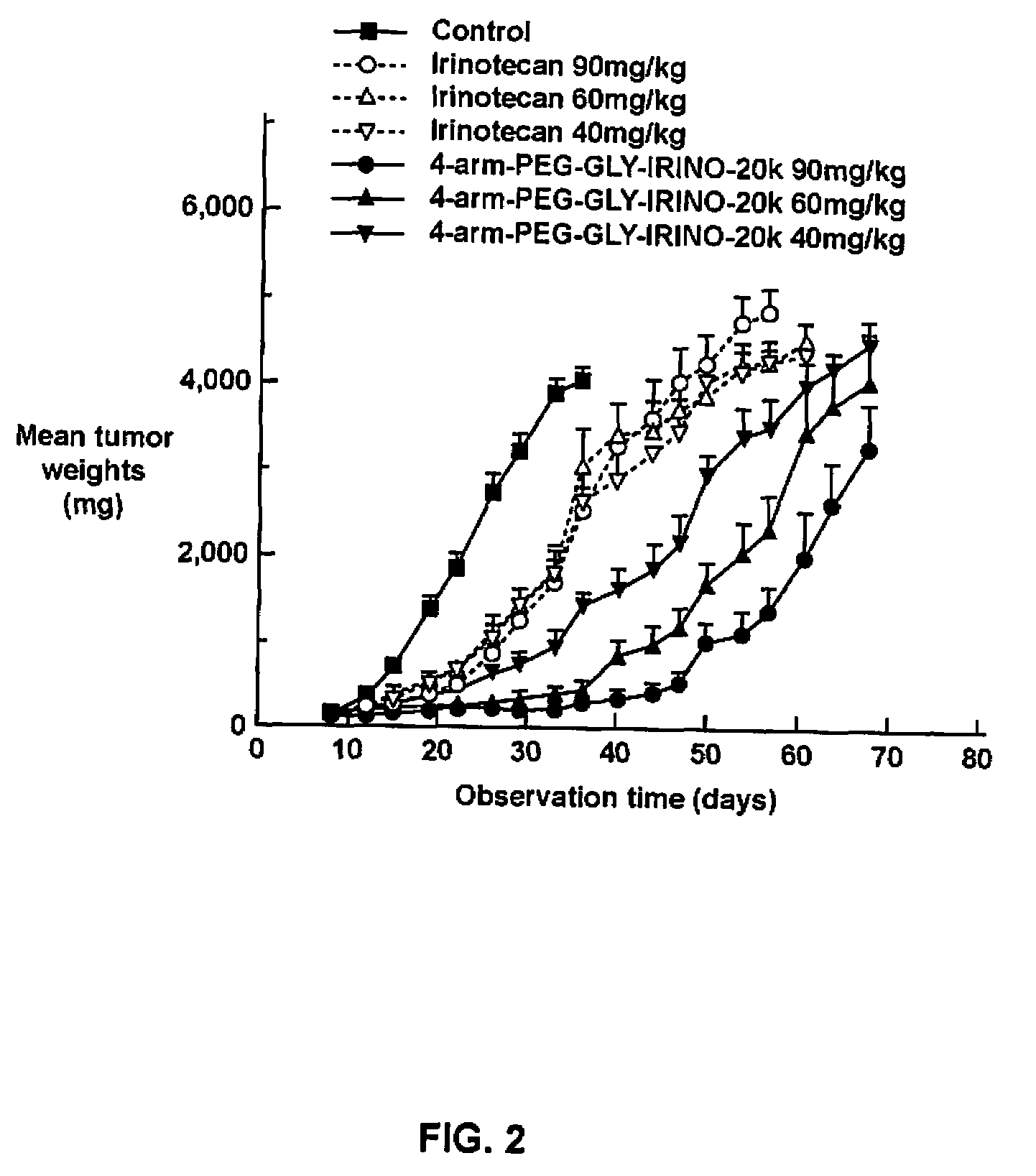Multi-Arm Polymer Prodrugs
a polymer and conjugate technology, applied in the field of multi-arm, watersoluble polymer drug conjugates, can solve the problems of poor aqueous solubility of pharmaceutical agents, low bioavailability, unstable, etc., and achieve the effect of optimizing the polymer size and structure, improving drug loading, and improving drug loading
- Summary
- Abstract
- Description
- Claims
- Application Information
AI Technical Summary
Benefits of technology
Problems solved by technology
Method used
Image
Examples
example 1
Synthesis of Pentaerythritolyl-4-Arm-(PEG-1-Methylene-2 Oxo-Vinylamino Acetate linked-Irinotecan)-20K
[0332]The product was synthesized via a three-step process using as starting materials irinotecan hydrochloride and 4-arm polyethylene glycol succinimidyl acetate. The yields at each step were typically greater than about 90%.
A. Synthesis of t-Boc-Glycine-Irinotecan
[0333]In a flask, 0.1 g Irinotecan (0.1704 mmoles), 0.059 g t-Boc-Glycine (0.3408 mmoles), and 0.021 g DMAP (0.1704 mmoles) were dissolved in 13 mL of anhydrous dichloromethane (DCM). To the solution was added 0.070 g DCC (0.3408 mmoles) dissolved in 2 mL of anhydrous DCM. The solution was stirred overnight at room temperature. The solid was removed through a coarse frit, and the solution was washed with 10 mL of 0.1 NHCL in a separatory funnel. The organic phase was further washed with 10 mL of deionized H2O in a separatory funnel and then dried with Na2SO4. The solvent was removed using rotary evaporation and the product...
example 2
Anti-Tumor Activity of Pentaerythritolyl-4-Arm-(PEG-1-Methylene-2 Oxo-Vinylamino Acetate Linked-Irinotecan)-20K, “4-arm-peg-gly-Irino-20K” in a Colon Cancer Mouse Xenograft Model
[0342]Human HT29 colon tumor xenografts were subcutaneously implanted in athymic nude mice. After about two weeks of adequate tumor growth (100 to 250 mg), these animals were divided into different groups of ten mice each. One group was dosed with normal saline (control), a second group was dosed with 60 mg / kg of irinotecan, and the third group was dosed with 60 mg / kg of the 4-arm PEG-GLY-Irino-20K (dose calculated per irinotecan content). Doses were administered intravenously, with one dose administered every 4 days for a total of 3 administered doses. The mice were observed daily and the tumors were measured with calipers twice a week. FIG. 1 shows the effect of irinotecan and PEG-irinotecan treatment on HT29 colon tumors in athymic nude mice.
[0343]As can be seen from the results depicted in FIG. 1, mice t...
example 3
Synthesis of Pentaerythritolyl-4-Arm-(PEG-1-Methylene-2 Oxo-Vinylamino Acetate Linked-Irinotecan)-40K, “4-Arm-peg-gly-irino-40k”
[0344]4-arm-PEG-GLY-IRINO-40K was prepared in an identical fashion to that described for the 20K compound in Example 1, with the exception that in step C, the multi-armed activated PEG reagent employed was 4 arm-PEG(40K)-CM rather than the 20K material.
[0345]In a 2 L round bottom reactor, 4-arm-PEG40k-SCM (240 g) was dissolved in 1.0 L anhydrous methylene chloride. To a separate 500 mL round bottom reactor, glycine-irinotecan TFA salt (1.0 equiv, 20 g) was dissolved in 53 mL DMF and treated with 8.8 mL TEA, stirred at room temperature for 5 minutes. Then the solution was added to the solution of 4-arm-PEG40k-SCM in methylene chloride. The reaction was stirred at RT for 15 hrs and then precipitated in 6 L Et2O and filtered to isolate solid product, which was dissolved in 2.0 L IPA and 200 ml methanol at 60° C. in a 5 L round bottom reactor. While stirred by ...
PUM
| Property | Measurement | Unit |
|---|---|---|
| Time | aaaaa | aaaaa |
| Fraction | aaaaa | aaaaa |
| Fraction | aaaaa | aaaaa |
Abstract
Description
Claims
Application Information
 Login to View More
Login to View More - R&D
- Intellectual Property
- Life Sciences
- Materials
- Tech Scout
- Unparalleled Data Quality
- Higher Quality Content
- 60% Fewer Hallucinations
Browse by: Latest US Patents, China's latest patents, Technical Efficacy Thesaurus, Application Domain, Technology Topic, Popular Technical Reports.
© 2025 PatSnap. All rights reserved.Legal|Privacy policy|Modern Slavery Act Transparency Statement|Sitemap|About US| Contact US: help@patsnap.com



